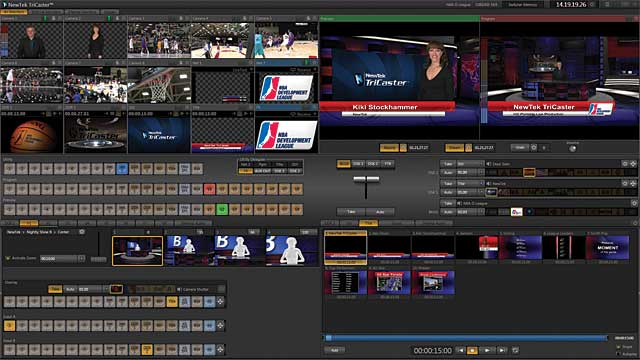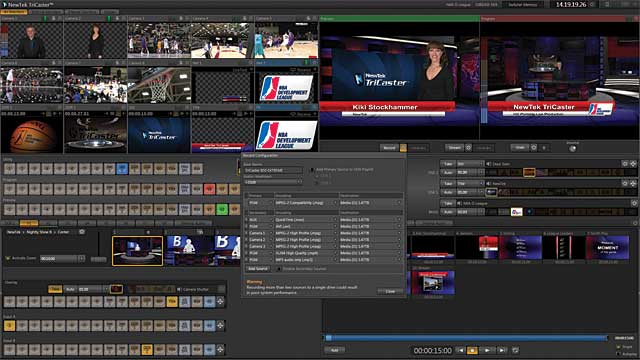Review: NewTek TriCaster TCXD850 Extreme
NewTek’s TriCaster all-in-one video mixers have a long history in portable live production (we reviewed our first TriCaster back in 2006). But in recent years, the ability to both stream and record a live production has pushed the TriCaster into the next level of live productions. As part of that push, NewTek has introduced a series of rack-mounted TriCasters, the TCXD series, with the first and most robust being the TriCaster TCXD850 Extreme (TCXD850X).
The 4 RU (7" high) unit fits into four slots of a standard data equipment rack and looks more like a server than a live production video mixer — at least from the front. While most TriCasters have all the BNC and XLR audio and video connectors on the front, the TCXD850X “hides” the video and audio connectors on the back, reminding users that this TriCaster leans toward studio or broadcast facility integration rather than field production.
The TriCaster TCXD850X also has the highest number of simultaneous video inputs (eight) and simultaneous video outputs (three) of any TriCaster on the market. TCXD850X is the second generation of this model, leveraging all the goodness of the original TriCaster 850, which NewTek launched in 2010.
The Hardware
The physical pieces comprising the TriCaster TCXD850X are a Windows-based system and up to two human-user-interface (HUI) devices.
HUI DEVICES
The TCXD850X is controlled by either a keyboard and a mouse or a large tactile control surface that mimics many of the on-screen buttons that are part of the TriCaster’s software user interface. The most popular control surface for the TCXD850X is the TriCaster 850 CS. Most users would probably opt for TriCaster 850 CS over a keyboard and a mouse because the control surface’s buttons are straightforward, and they provide visual feedback by changing colors when pressed. What users may not know is that the TriCaster 850 CS actually provides up to three times the button options, thanks to the ALT and FTN (function) buttons at the top row. This provides a number of extra shortcuts that would take several clicks of a mouse.

The TCXD850X’s on-screen user interface mimics all the buttons of the TCXD850 control surface, plus a number of input, preview, and output monitors.
For those who may already have a TriCaster, it’s worth noting that the venerable LC-11 control surface can also be used to control the TriCaster TCXD850X. NewTek’s Dan Parker pointed out that the LC-11 has an ALT button; holding down the ALT button shifts the six- input LC-11 to an alternate set of six inputs, allowing control of the TCXD850X’s last four video inputs as well as the second DDR (digital disc recorder). The LC-11 lacks a joystick, however, making virtual set movements cumbersome via mouse-only access to virtual set controls on-screen in the TriCaster interface.
One other HUI can be used: the TriCaster 850 TW. A “time warper” of sorts, TriCaster 850 TW allows for slow motion and instant replay when connected to a TriCaster system that supports Media Players (DDRs). A separate operator can select, mark, and play back clips at various slow-motion speeds, while leaving the original operator of the TriCaster 850 CS to handle the video mixing requirements.
One HUI that seems lacking for this type of studio-integrated device is an audio mixer HUI. There are several on the market, and this option would allow one person to focus on audio mixing while the primary operator focuses on video mixing. At the moment, the only way to do so appears to be by using of a mouse on-screen, which takes up real estate and mind-share from the primarily video-driven mixing methodology employed by NewTek for the TriCaster. The use of an audio HUI was less of an issue for field-based productions, on the assumption that an outboard audio mixer might be used. But TCXD850X approaches a number of audio inputs that potentially require a dedicated audio person.
WINDOWS-BASED SYSTEM
Unlike earlier TriCasters with square (and shallower) form factors that worked for desktop- and field-based use cases, the size and bulk of the TCXD850X is one of the first indications this TriCaster is designed to be permanently mounted. Yet NewTek didn’t waste any space in this Extreme version, offering a combination of Sandy Bridge bus architectures and robust processing, with two Intel i7 quad core 3.4 GHz processors. That’s a total of eight cores, and NewTek takes advantage of the multicore/multithreading capabilities in several of its features.
One question often asked about the use of a Windows-based system for a live video production mixer is that of redundancy. Here, it appears that NewTek tries hard to minimize the issues surrounding Windows and PC-based live video mixing. TCXD850X relies on Windows 7 Professional 64-bit for its operating system but hides it in the background, moving some utility functions within the TriCaster program itself to minimize the need to exit into Windows.

You can fine-tune audio on-screen with advanced mixing controls, but it distracts from the video mixing. An audio mixer HUI would be a great addition.
Power redundancy is robust on the TriCaster TCXD850X; the unit contains two hot-swappable power supplies, each with an audible warning beep that continues until the unit is replaced. The decibel level and insistence of the warning may be distracting in the middle of a production in closed quarters, but our testing found it does its job well in alerting to the potential loss of power redundancy.
On both the TCXD850 and TCXD850X units, only 1GB Ethernet connector is present. A single Ethernet connector makes sense for field-deployed TriCasters, but it makes little sense on a rack-mounted unit that claims streaming as one of its key features. The lack of a second Ethernet connector means failover and load balancing between network switches isn’t possible.
The video loop-through capability on the TCXD850X is a nice touch. NewTek has included a hardware loop on the video 7 input to counteract the potential significant loss of video signal during an inadvertent restart or power loss. The video input can be set for analog (Composite, Component, or Y/C) or SDI via the TriCaster’s software, and the video input chosen can then be paired with either embedded AES digital audio (for SDI) or with analog audio inputs 7a or 7b (for either SDI or analog video). Regardless of the combination of inputs chosen for input 7, the selected inputs are then output to video and audio output 1, for either SDI output (with analog or embedded audio outs) or analog outputs (Component, Composite, or Y/C).
HARD DRIVES AND RECORDINGS
TCXD850X ships with drives to fill all four front-mounted hard drive bays. The media drives are technically JBOD (just a bunch of [independent] disks), but Windows technically would allow a RAID configuration between identical-sized drives. In addition, the drives are all the same storage size, making it easier to gauge how many hours of video recording are available on every drive, a key piece of information for recording content to the media drives.
Related Articles
The first plugin to use the TriCaster SDK, Livestream offers one-click high-def encoding.
31 Jan 2012
NewTek TriCaster TCXD850 CS provides a physical connection including a three-axis joystick controller
17 Feb 2011